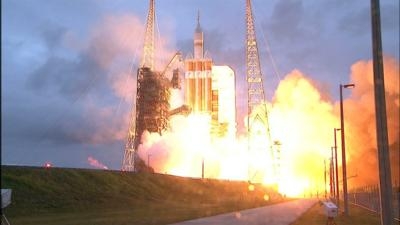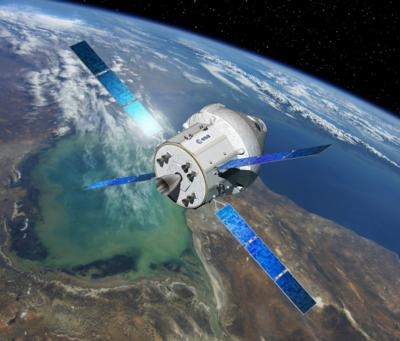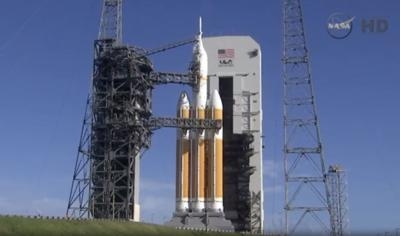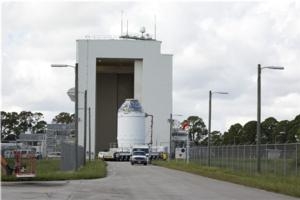Orion Mission Represents A Step Towards A Return To Manned Spaceflight For The U.S.A.
Eyewitness Account By ANN Space Analyst Wes Oleszewski
At ignition, the three RS-68 engines of the Delta IV Heavy were each producing 702,000 pounds of thrust as Orion took flight with 2.1 million pounds of thrust beneath it. The engines were started in a staggered fashion to reduce the charring effect of the booster’s foam insulation seen in previous flights. That was caused by lingering hydrogen caused by the RS-68 start sequence.

The method worked, since almost no charring was observed on the departing booster. Crowds of on-lookers and news media alike were shaken by the roar as the most powerful booster currently in the US inventory slowly lifted off from Launch Complex 37; the Exploration Flight Test 1 (EFT-1) was under way. Exhausting three legs of bright orange flame against the gloomy gray sky, the vehicle was in sight for just under sixty seconds before it slowly pierced the thick overcast of clouds.
Just 50 seconds after liftoff, the center engine of the Delta IV Heavy was throttled back to 57% of its thrust while the outboard engines kept burning at 100%. At one minute and 23 seconds after liftoff, the vehicle reached the point where the dynamic pressure on the vehicle was at its greatest, known as “Max-Q.” Two seconds after Max-Q the vehicle exceeded Mach 1. The first step in the process of staging took place at three minutes and 55 seconds when the two outboard engines of the Delta IV Heavy also throttled back to 57% of thrust. This was a step to reduce the shock of staging imposed upon the vehicle and its payload. Just five seconds after the throttle down of the outboard CBCs, they were shut down and jettisoned. Next, the core CBC was throttled back up to 100%. Finally, at four minutes and 15 seconds into the flight the core CBC was shut down and dropped away.

After a brief 15 second glide the Delta Cryogenic Second Stage (DCSS) ignited on time and began to push Orion toward orbit. Since the EFT-1 mission does not require a service module and because the service module itself is still in development the DCSS acted as the service module. The DCSS burned for six minutes and 26 seconds. During that burn the first two critical tests of the Orion configuration took place. The first came 21 seconds after the DCSS ignited, and was the jettison of the “panels” that surrounded the dummy service module.
The second major task was the jettison of the Launch Abort System (LAS) also known as the escape tower. At 17 minutes and 17 seconds into the FET-1 mission, the DCSS shut down its RL10B engine and NASA’s first new spacecraft intended for human flight since 1969 was in space -- Orion.
Once in orbit the Orion EFT-1 spacecraft was put through a series of critical tests. Two test objectives had already been met. The first objective was the jettisoning of the “panels.” These were three 13X14 foot semi-cylindrical support panels that provided additional strength to the Orion and Delta Cryogenic Second Stage combination. Those panels were separated at an altitude of 578,580 feet. Five seconds later, the Launch Abort System also jettisoned at an altitude of 579,150 feet.

Shutdown of the DCSS took place after six minutes and 26 seconds. For most of the first orbit following that shutdown, Orion coasted. At one hour and 55 minutes into the flight, the DCSS ignited its RL10B engine for a second time. This time, the engine burned for four minutes and 43 seconds, and sent Orion up to an altitude of 3,604.2 statute miles. On the way up, cameras inside the Orion broadcast live TV of the crescent earth in the distance.
By three hours and 23 minutes into the mission, it was time to jettison the DCSS stage and do the most dangerous test of all; reentry. Minus its DCSS, the Orion spacecraft impacted the atmosphere at a velocity just under 20,000 miles per hour. It came through reentry in fine shape and a NASA drone equipped with a TV camera followed Orion home as the world watched the red and white parachutes open. About the only thing that was not seen was the actual splashdown itself. Orion descended into a fog bank and was lost by the cameras. Moments later, it was spotted floating on the Pacific Ocean’s surface safe and sound. The mission of EFT-1 was accomplished without a flaw.
(NASA Images)



 ANN's Daily Aero-Linx (04.16.24)
ANN's Daily Aero-Linx (04.16.24) Aero-News: Quote of the Day (04.16.24)
Aero-News: Quote of the Day (04.16.24) Airborne 04.10.24: SnF24!, A50 Heritage Reveal, HeliCycle!, Montaer MC-01
Airborne 04.10.24: SnF24!, A50 Heritage Reveal, HeliCycle!, Montaer MC-01 Airborne 04.12.24: SnF24!, G100UL Is Here, Holy Micro, Plane Tags
Airborne 04.12.24: SnF24!, G100UL Is Here, Holy Micro, Plane Tags Airborne-Flight Training 04.17.24: Feds Need Controllers, Spirit Delay, Redbird
Airborne-Flight Training 04.17.24: Feds Need Controllers, Spirit Delay, Redbird








